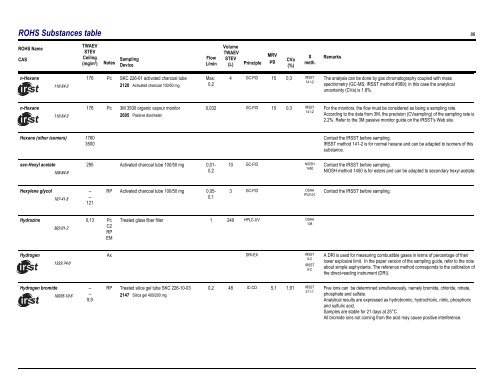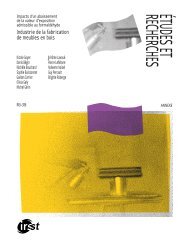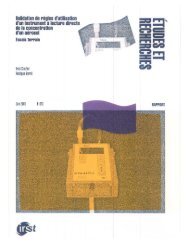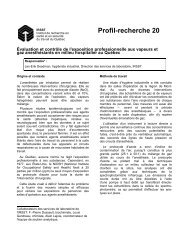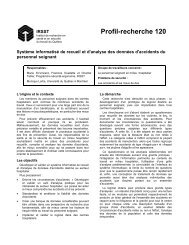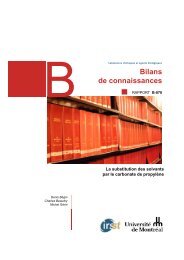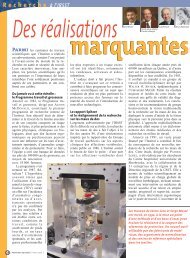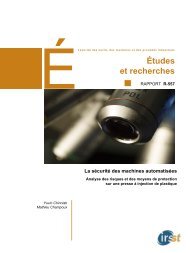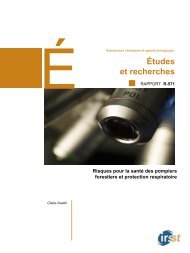Sampling Guide for Air Contaminants in the Workplace - Irsst
Sampling Guide for Air Contaminants in the Workplace - Irsst
Sampling Guide for Air Contaminants in the Workplace - Irsst
You also want an ePaper? Increase the reach of your titles
YUMPU automatically turns print PDFs into web optimized ePapers that Google loves.
ROHS Substances table<br />
86<br />
ROHS Name<br />
CAS<br />
TWAEV<br />
STEV<br />
Ceil<strong>in</strong>g<br />
(mg/m³)<br />
Notes<br />
<strong>Sampl<strong>in</strong>g</strong><br />
Device<br />
Flow<br />
L/m<strong>in</strong><br />
Volume<br />
TWAEV<br />
STEV<br />
(L)<br />
Pr<strong>in</strong>ciple<br />
MRV<br />
µg<br />
CVa<br />
(%)<br />
#<br />
meth.<br />
Remarks<br />
n-Hexane<br />
110-54-3<br />
176 Pc SKC 226-01 activated charcoal tube<br />
Max: 4 GC-FID 15 0,3 IRSST<br />
141-2<br />
2120 Activated charcoal 100/50 mg<br />
0,2<br />
The analysis can be done by gas chromatography coupled with mass<br />
spectrometry (GC-MS, IRSST method #369); <strong>in</strong> this case <strong>the</strong> analytical<br />
uncerta<strong>in</strong>ty (CVa) is 1.8%.<br />
n-Hexane<br />
110-54-3<br />
176 Pc 3M 3500 organic vapour monitor<br />
0,032 GC-FID 15 0,3 IRSST<br />
141-2<br />
2695 Passive dosimeter<br />
For <strong>the</strong> monitors, <strong>the</strong> flow must be considered as be<strong>in</strong>g a sampl<strong>in</strong>g rate.<br />
Accord<strong>in</strong>g to <strong>the</strong> data from 3M, <strong>the</strong> precision (CVsampl<strong>in</strong>g) of <strong>the</strong> sampl<strong>in</strong>g rate is<br />
2.2%. Refer to <strong>the</strong> 3M passive monitor guide on <strong>the</strong> IRSST's Web site.<br />
Hexane (o<strong>the</strong>r isomers)<br />
1760<br />
3500<br />
Contact <strong>the</strong> IRSST be<strong>for</strong>e sampl<strong>in</strong>g.<br />
IRSST method 141-2 is <strong>for</strong> normal hexane and can be adapted to isomers of this<br />
substance.<br />
sec-Hexyl acetate<br />
108-84-9<br />
295 Activated charcoal tube 100/50 mg<br />
0,01- 10 GC-FID<br />
NIOSH<br />
1450<br />
0,2<br />
Contact <strong>the</strong> IRSST be<strong>for</strong>e sampl<strong>in</strong>g.<br />
NIOSH method 1450 is <strong>for</strong> esters and can be adapted to secondary hexyl acetate.<br />
Hexylene glycol<br />
107-41-5<br />
--<br />
--<br />
121<br />
RP Activated charcoal tube 100/50 mg<br />
0,05- 3 GC-FID<br />
OSHA<br />
PV2101<br />
0,1<br />
Contact <strong>the</strong> IRSST be<strong>for</strong>e sampl<strong>in</strong>g.<br />
Hydraz<strong>in</strong>e<br />
302-01-2<br />
0,13 Pc<br />
C2<br />
RP<br />
EM<br />
Treated glass fiber filter<br />
1 240 HPLC-UV<br />
OSHA<br />
108<br />
Hydrogen<br />
1333-74-0<br />
Ax<br />
DRI-EX<br />
IRSST<br />
9-C<br />
IRSST<br />
9-C<br />
A DRI is used <strong>for</strong> measur<strong>in</strong>g combustible gases <strong>in</strong> terms of percentage of <strong>the</strong>ir<br />
lower explosive limit. In <strong>the</strong> paper version of <strong>the</strong> sampl<strong>in</strong>g guide, refer to <strong>the</strong> note<br />
about simple asphyxiants. The reference method corresponds to <strong>the</strong> calibration of<br />
<strong>the</strong> direct-read<strong>in</strong>g <strong>in</strong>strument (DRI).<br />
Hydrogen bromide<br />
10035-10-6<br />
--<br />
--<br />
9,9<br />
RP Treated silica gel tube SKC 226-10-03 0,2 48 IC-CD 5,1 1,91 IRSST<br />
211-1<br />
2147 Silica gel 400/200 mg<br />
Five ions can be determ<strong>in</strong>ed simultaneously, namely bromide, chloride, nitrate,<br />
phosphate and sulfate.<br />
Analytical results are expressed as hydrobromic, hydrochloric, nitric, phosphoric<br />
and sulfuric acid.<br />
Samples are stable <strong>for</strong> 21 days at 25°C.<br />
All bromide ions not com<strong>in</strong>g from <strong>the</strong> acid may cause positive <strong>in</strong>terference.


